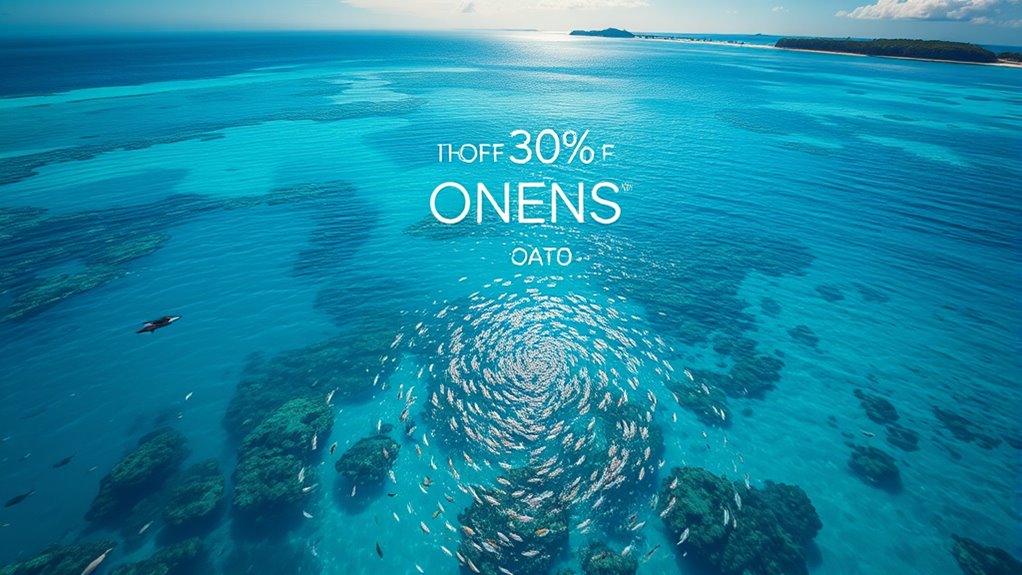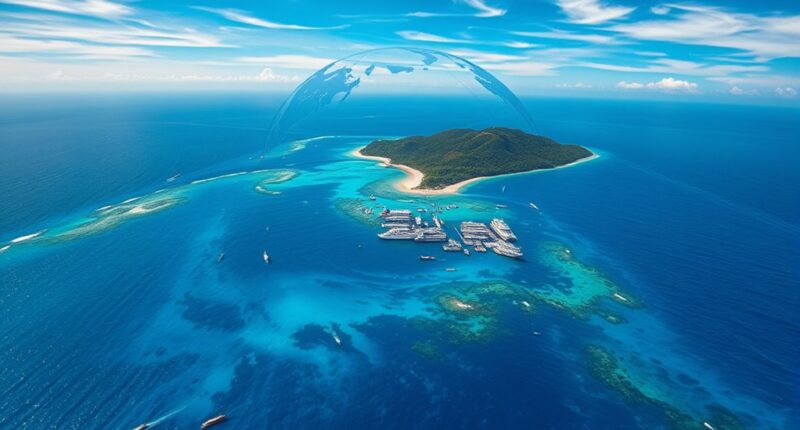The UN has voted to protect 30% of the world’s oceans by 2030 as part of a global effort to conserve marine ecosystems and promote sustainable practices. This initiative emphasizes international cooperation, community engagement, and effective policies to safeguard marine biodiversity. Your awareness and actions can contribute to these goals, such as reducing pollution and supporting ocean-friendly brands. Keep exploring to discover more ways you can help defend our oceans and ensure their health for future generations.
Key Takeaways
- The UN approved a global initiative to protect 30% of the world’s oceans by 2030.
- This effort aims to preserve marine biodiversity and ecosystems worldwide.
- International cooperation and diplomacy are essential for establishing effective marine protected areas.
- The initiative emphasizes community engagement, sustainable practices, and pollution reduction.
- Funding and policy support are being promoted to implement conservation strategies globally.

The United Nations has voted to protect 30% of the world’s oceans by 2030, marking a significant step in global efforts to preserve marine ecosystems. This ambitious goal emphasizes the importance of marine conservation and acknowledges that safeguarding our oceans requires coordinated international cooperation. As someone invested in the health of our planet, you play an essential role in supporting these efforts by staying informed and advocating for policies that prioritize ocean health. The initiative recognizes that no single nation can face the challenges of overfishing, pollution, and climate change alone. Instead, it calls for countries across the globe to work together, sharing resources, knowledge, and strategies to establish protected areas that foster biodiversity and resilience.
International cooperation becomes crucial because oceans are interconnected, and threats in one region can quickly impact others. When nations collaborate on marine conservation, they create stronger protections that benefit entire ecosystems rather than isolated pockets. For example, establishing marine protected areas (MPAs) requires consensus on boundaries, regulations, and enforcement, which only happens effectively through diplomatic partnerships. Your voice can influence these collaborations by supporting organizations and initiatives that promote international agreements on marine conservation. By doing so, you help reinforce the message that protecting oceans isn’t just a local issue but a global responsibility. Additionally, fostering community engagement and education is vital to ensure the success of conservation initiatives. Efforts to develop sustainable fishing practices and reduce ocean pollution are integral parts of this global strategy. Moreover, implementing marine spatial planning can optimize the use of ocean resources while minimizing environmental impacts.
The vote signals a shift toward more sustainable management of marine resources. It encourages governments to prioritize conservation in their policies, allocate funding for marine research, and implement measures to reduce pollution and illegal fishing. Your awareness of these policies can make a difference, especially when engaging with community projects or supporting brands committed to ocean-friendly practices. Marine conservation isn’t solely about setting aside protected zones; it also involves restoring degraded habitats, reducing plastic waste, and promoting sustainable fishing practices. Supporting public awareness campaigns helps educate communities about the importance of ocean preservation and the impact of individual actions on marine ecosystems. Recognizing the role of marine protected areas is essential in creating a comprehensive approach to ocean health.
Frequently Asked Questions
How Will This Initiative Impact Local Fishing Industries?
This initiative will likely impact your local fishing industry by promoting fishing sustainability, which may mean stricter regulations and protected areas. While these measures aim to preserve fish populations, they could cause economic implications, such as reduced catches or shifts in fishing zones. You might need to adapt your practices to stay compliant, but ultimately, these efforts can help guarantee long-term fish availability and support the resilience of your community’s fishing economy.
What Are the Main Challenges in Establishing Marine Protected Areas?
Although establishing marine protected areas faces subtle hurdles, you’ll find that safeguarding marine biodiversity requires steering through complex challenges. You must foster international cooperation, balancing diverse interests and policies. Ensuring effective enforcement and securing sustainable funding can be tricky, but with shared commitment, these areas become vital for ocean health. Recognizing interconnected ecosystems, you realize that overcoming these challenges is essential to preserve marine life for future generations.
How Will Funding for Enforcement and Management Be Secured?
You can guarantee funding for enforcement and management by implementing diverse funding strategies like public-private partnerships, international grants, and eco-tourism revenue. Engaging local communities and stakeholders in marine conservation helps build support and shared responsibility. You should advocate for dedicated government budgets and explore innovative financing options, such as biodiversity offsets or blue bonds. These strategies ensure sustainable funding, empowering you to effectively protect marine areas and meet conservation goals.
What Role Do Indigenous Communities Play in Ocean Protection?
You might think indigenous communities only have cultural ties, but their role in ocean protection is essential. Indigenous stewardship, guided by traditional knowledge, offers sustainable practices that preserve marine ecosystems. By actively involving these communities, you harness centuries of experience, ensuring effective conservation. Their deep understanding fosters respect for the ocean, empowering you to make informed, culturally sensitive decisions that benefit both local environments and global sustainability efforts.
How Does This Resolution Align With Global Climate Change Efforts?
You see that protecting 30% of oceans supports global climate change efforts by safeguarding marine biodiversity, which helps regulate climate and store carbon. This resolution encourages international cooperation, uniting countries to preserve essential ecosystems. By working together, you can help reduce climate impacts, promote resilience, and guarantee healthy oceans for future generations. Ultimately, it aligns with broader goals to combat climate change and protect our planet’s natural resources.
Conclusion
You might wonder if safeguarding 30% of oceans by 2030 can truly make a difference. The UN’s bold move aims to restore ecosystems and combat climate change, but some skeptics argue it’s just a lofty goal. However, evidence suggests that protecting large ocean areas boosts biodiversity and helps absorb carbon. If you believe in the power of collective action, supporting this initiative could be your best chance to ensure healthier oceans for generations to come.








